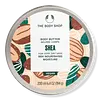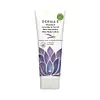The Body Shop Body Butter Versus Derma E Vitamin E Lavender & Neroli Skin Smoothing Shea Body Lotion
What's inside
What's inside
 Key Ingredients
Key Ingredients

 Benefits
Benefits

 Concerns
Concerns

 Ingredients Side-by-side
Ingredients Side-by-side

Water
Skin ConditioningButyrospermum Parkii Butter
Skin ConditioningCetearyl Alcohol
EmollientTheobroma Cacao Seed Butter
EmollientGlycerin
HumectantCetearyl Glucoside
EmulsifyingTriethyl Citrate
MaskingOrbignya Oleifera Seed Oil
EmollientDimethicone
EmollientOryza Sativa Bran Wax
Skin ConditioningPhenoxyethanol
PreservativeSodium Stearoyl Glutamate
CleansingParfum
MaskingCaprylyl Glycol
EmollientXanthan Gum
EmulsifyingTocopherol
AntioxidantCitric Acid
BufferingLinalool
PerfumingCoumarin
PerfumingAlpha-Isomethyl Ionone
PerfumingLimonene
PerfumingCaramel
Cosmetic ColorantCI 19140
Cosmetic ColorantWater, Butyrospermum Parkii Butter, Cetearyl Alcohol, Theobroma Cacao Seed Butter, Glycerin, Cetearyl Glucoside, Triethyl Citrate, Orbignya Oleifera Seed Oil, Dimethicone, Oryza Sativa Bran Wax, Phenoxyethanol, Sodium Stearoyl Glutamate, Parfum, Caprylyl Glycol, Xanthan Gum, Tocopherol, Citric Acid, Linalool, Coumarin, Alpha-Isomethyl Ionone, Limonene, Caramel, CI 19140
Water
Skin ConditioningAloe Barbadensis Leaf Juice
Skin ConditioningCarthamus Tinctorius Seed Oil
MaskingGlycerin
HumectantGlyceryl Stearate Citrate
EmollientCetyl Alcohol
EmollientLactic Acid
BufferingStearic Acid
CleansingTocopheryl Acetate
AntioxidantSodium Hyaluronate
HumectantCeramide Ng
Skin ConditioningVaccinium Macrocarpon Seed Oil
Skin ConditioningSimmondsia Chinensis Seed Oil
EmollientElaeis Guineensis Oil
EmollientOlea Europaea Fruit Oil
MaskingPanthenol
Skin ConditioningCamellia Sinensis Leaf Extract
AntimicrobialButyrospermum Parkii Butter
Skin ConditioningAllantoin
Skin ConditioningGlyceryl Stearate
EmollientGlyceryl Stearate Se
EmulsifyingCetearyl Alcohol
EmollientCetearyl Glucoside
EmulsifyingSalicylic Acid
MaskingGlycolic Acid
BufferingSodium Hydroxide
BufferingPotassium Sorbate
PreservativeSodium Phytate
Phenoxyethanol
PreservativeEthylhexylglycerin
Skin ConditioningParfum
MaskingWater, Aloe Barbadensis Leaf Juice, Carthamus Tinctorius Seed Oil, Glycerin, Glyceryl Stearate Citrate, Cetyl Alcohol, Lactic Acid, Stearic Acid, Tocopheryl Acetate, Sodium Hyaluronate, Ceramide Ng, Vaccinium Macrocarpon Seed Oil, Simmondsia Chinensis Seed Oil, Elaeis Guineensis Oil, Olea Europaea Fruit Oil, Panthenol, Camellia Sinensis Leaf Extract, Butyrospermum Parkii Butter, Allantoin, Glyceryl Stearate, Glyceryl Stearate Se, Cetearyl Alcohol, Cetearyl Glucoside, Salicylic Acid, Glycolic Acid, Sodium Hydroxide, Potassium Sorbate, Sodium Phytate, Phenoxyethanol, Ethylhexylglycerin, Parfum
 Reviews
Reviews

Ingredients Explained
These ingredients are found in both products.
Ingredients higher up in an ingredient list are typically present in a larger amount.
This ingredient is also known as shea butter. It is an effective skin hydrator and emollient.
Emollients help soothe and soften your skin. It does this by creating a protective film on your skin. This barrier helps trap moisture and keeps your skin hydrated. Emollients may be effective at treating dry or itchy skin.
Shea butter is rich in antioxidants. Antioxidants help fight free-radicals, or molecules that may harm the body. It is also full of fatty acids including stearic acid and linoleic acid. These acids help replenish the skin and keep skin moisturized.
While Shea Butter has an SPF rating of about 3-4, it is not a sunscreen replacement.
Shea butter may not be fungal acne safe. We recommend speaking with a professional if you have any concerns.
Learn more about Butyrospermum Parkii ButterCetearyl alcohol is a mixture of two fatty alcohols: cetyl alcohol and stearyl alcohol. It is mainly used as an emulsifier. Emulsifiers help prevent the separation of oils and products. Due to its composition, it can also be used to thicken a product or help create foam.
Cetearyl alcohol is an emollient. Emollients help soothe and hydrate the skin by trapping moisture.
Studies show Cetearyl alcohol is non-toxic and non-irritating. The FDA allows products labeled "alcohol-free" to have fatty alcohols.
This ingredient is usually derived from plant oils such as palm, vegetable, or coconut oils. There is debate on whether this ingredient will cause acne.
Due to the fatty acid base, this ingredient may not be Malassezia folliculitis safe.
Learn more about Cetearyl AlcoholCetearyl Glucoside is a surfactant and emulsifier. It can be produced from synthetic of natural sources of cetearyl alcohol and glucose.
Emulsifiers help prevent ingredients from separating, such as oils and waters. It can also be used to enhance the texture of products.
As a surfactant, Cetearyl Glucoside helps during the cleansing process. By gathering all the dirt and oils, it allows these molecules to be washed away easily.
Learn more about Cetearyl GlucosideGlycerin is already naturally found in your skin. It helps moisturize and protect your skin.
A study from 2016 found glycerin to be more effective as a humectant than AHAs and hyaluronic acid.
As a humectant, it helps the skin stay hydrated by pulling moisture to your skin. The low molecular weight of glycerin allows it to pull moisture into the deeper layers of your skin.
Hydrated skin improves your skin barrier; Your skin barrier helps protect against irritants and bacteria.
Glycerin has also been found to have antimicrobial and antiviral properties. Due to these properties, glycerin is often used in wound and burn treatments.
In cosmetics, glycerin is usually derived from plants such as soybean or palm. However, it can also be sourced from animals, such as tallow or animal fat.
This ingredient is organic, colorless, odorless, and non-toxic.
Glycerin is the name for this ingredient in American English. British English uses Glycerol/Glycerine.
Learn more about GlycerinParfum is a catch-all term for an ingredient or more that is used to give a scent to products.
Also called "fragrance", this ingredient can be a blend of hundreds of chemicals or plant oils. This means every product with "fragrance" or "parfum" in the ingredients list is a different mixture.
For instance, Habanolide is a proprietary trade name for a specific aroma chemical. When used as a fragrance ingredient in cosmetics, most aroma chemicals fall under the broad labeling category of “FRAGRANCE” or “PARFUM” according to EU and US regulations.
The term 'parfum' or 'fragrance' is not regulated in many countries. In many cases, it is up to the brand to define this term.
For instance, many brands choose to label themselves as "fragrance-free" because they are not using synthetic fragrances. However, their products may still contain ingredients such as essential oils that are considered a fragrance by INCI standards.
One example is Calendula flower extract. Calendula is an essential oil that still imparts a scent or 'fragrance'.
Depending on the blend, the ingredients in the mixture can cause allergies and sensitivities on the skin. Some ingredients that are known EU allergens include linalool and citronellol.
Parfum can also be used to mask or cover an unpleasant scent.
The bottom line is: not all fragrances/parfum/ingredients are created equally. If you are worried about fragrances, we recommend taking a closer look at an ingredient. And of course, we always recommend speaking with a professional.
Learn more about ParfumPhenoxyethanol is a preservative that has germicide, antimicrobial, and aromatic properties. Studies show that phenoxyethanol can prevent microbial growth. By itself, it has a scent that is similar to that of a rose.
It's often used in formulations along with Caprylyl Glycol to preserve the shelf life of products.
Water. It's the most common cosmetic ingredient of all. You'll usually see it at the top of ingredient lists, meaning that it makes up the largest part of the product.
So why is it so popular? Water most often acts as a solvent - this means that it helps dissolve other ingredients into the formulation.
You'll also recognize water as that liquid we all need to stay alive. If you see this, drink a glass of water. Stay hydrated!
Learn more about Water